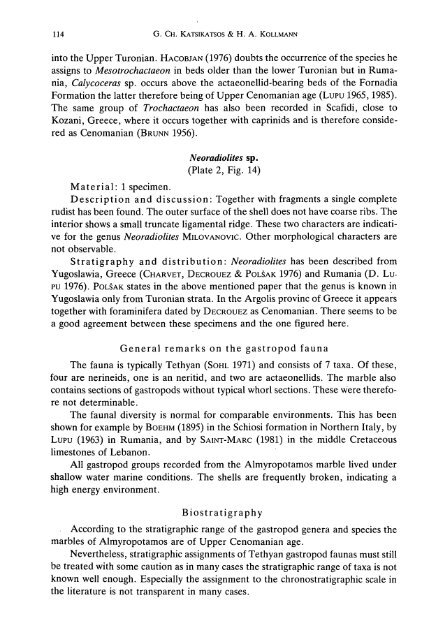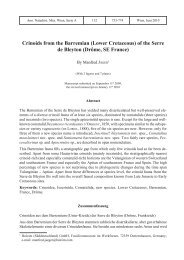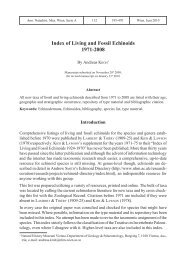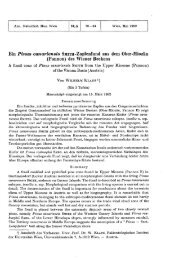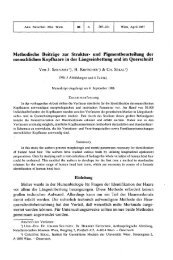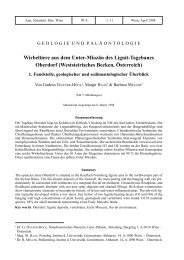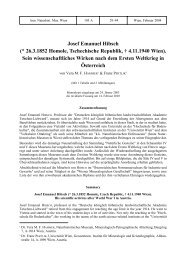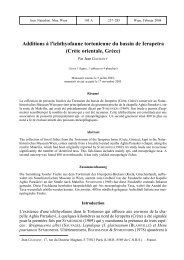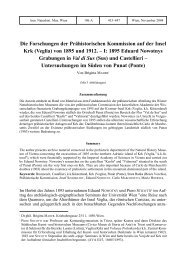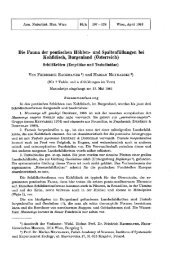An Upper Cretaceous Mollusc Fauna from the Marbles of ...
An Upper Cretaceous Mollusc Fauna from the Marbles of ...
An Upper Cretaceous Mollusc Fauna from the Marbles of ...
Create successful ePaper yourself
Turn your PDF publications into a flip-book with our unique Google optimized e-Paper software.
114 G. CH. KATSIKATSOS & H. A. KOLLMANN<br />
into <strong>the</strong> <strong>Upper</strong> Turonian. HACOBJAN (1976) doubts <strong>the</strong> occurrence <strong>of</strong> <strong>the</strong> species he<br />
assigns to Mesotrochactaeon in beds older than <strong>the</strong> lower Turonian but in Rumania,<br />
Calycoceras sp. occurs above <strong>the</strong> actaeonellid-bearing beds <strong>of</strong> <strong>the</strong> Fornadia<br />
Formation <strong>the</strong> latter <strong>the</strong>refore being <strong>of</strong> <strong>Upper</strong> Cenomanian age (LUPU 1965,1985).<br />
The same group <strong>of</strong> Trochactaeon has also been recorded in Scafidi, close to<br />
Kozani, Greece, where it occurs toge<strong>the</strong>r with caprinids and is <strong>the</strong>refore considered<br />
as Cenomanian (BRÜNN 1956).<br />
Neoradiolites sp.<br />
(Plate 2, Fig. 14)<br />
Material: 1 specimen.<br />
Description and discussion: Toge<strong>the</strong>r with fragments a single complete<br />
rudist has been found. The outer surface <strong>of</strong> <strong>the</strong> shell does not have coarse ribs. The<br />
interior shows a small truncate ligamental ridge. These two characters are indicative<br />
for <strong>the</strong> genus Neoradiolites MILOVANOVIC. O<strong>the</strong>r morphological characters are<br />
not observable.<br />
Stratigraphy and distribution: Neoradiolites has been described <strong>from</strong><br />
Yugoslawia, Greece (CHARVET, DECROUEZ & POLSAK 1976) and Rumania (D. Lupu<br />
1976). POLSAK states in <strong>the</strong> above mentioned paper that <strong>the</strong> genus is known in<br />
Yugoslawia only <strong>from</strong> Turonian strata. In <strong>the</strong> Argolis provine <strong>of</strong> Greece it appears<br />
toge<strong>the</strong>r with foraminifera dated by DECROUEZ as Cenomanian. There seems to be<br />
a good agreement between <strong>the</strong>se specimens and <strong>the</strong> one figured here.<br />
General remarks on <strong>the</strong> gastropod fauna<br />
The fauna is typically Tethyan (SOHL 1971) and consists <strong>of</strong> 7 taxa. Of <strong>the</strong>se,<br />
four are nerineids, one is an neritid, and two are actaeonellids. The marble also<br />
contains sections <strong>of</strong> gastropods without typical whorl sections. These were <strong>the</strong>refore<br />
not determinable.<br />
The faunal diversity is normal for comparable environments. This has been<br />
shown for example by BOEHM (1895) in <strong>the</strong> Schiosi formation in Nor<strong>the</strong>rn Italy, by<br />
LUPU (1963) in Rumania, and by SAINT-MARC (1981) in <strong>the</strong> middle <strong>Cretaceous</strong><br />
limestones <strong>of</strong> Lebanon.<br />
All gastropod groups recorded <strong>from</strong> <strong>the</strong> Almyropotamos marble lived under<br />
shallow water marine conditions. The shells are frequently broken, indicating a<br />
high energy environment.<br />
Biostratigraphy<br />
According to <strong>the</strong> stratigraphie range <strong>of</strong> <strong>the</strong> gastropod genera and species <strong>the</strong><br />
marbles <strong>of</strong> Almyropotamos are <strong>of</strong> <strong>Upper</strong> Cenomanian age.<br />
Never<strong>the</strong>less, stratigraphie assignments <strong>of</strong> Tethyan gastropod faunas must still<br />
be treated with some caution as in many cases <strong>the</strong> stratigraphie range <strong>of</strong> taxa is not<br />
known well enough. Especially <strong>the</strong> assignment to <strong>the</strong> chronostratigraphic scale in<br />
<strong>the</strong> literature is not transparent in many cases.


